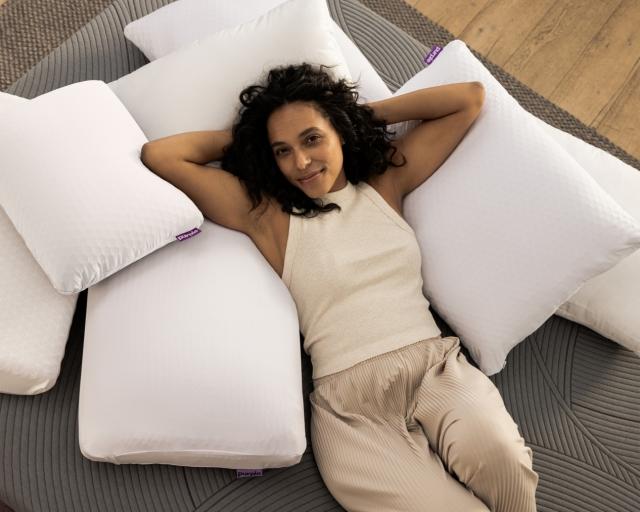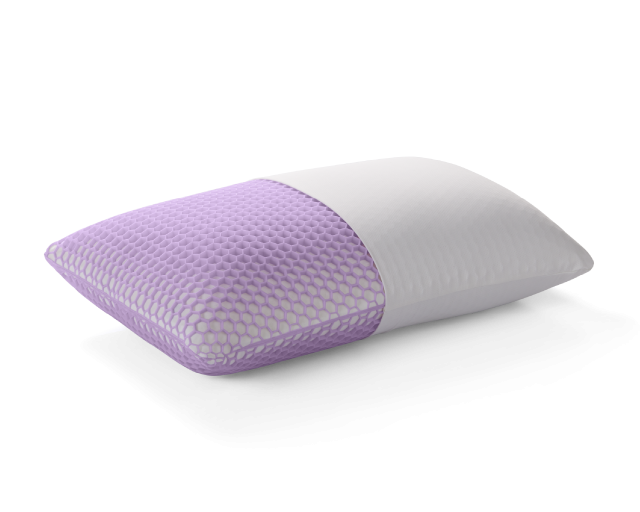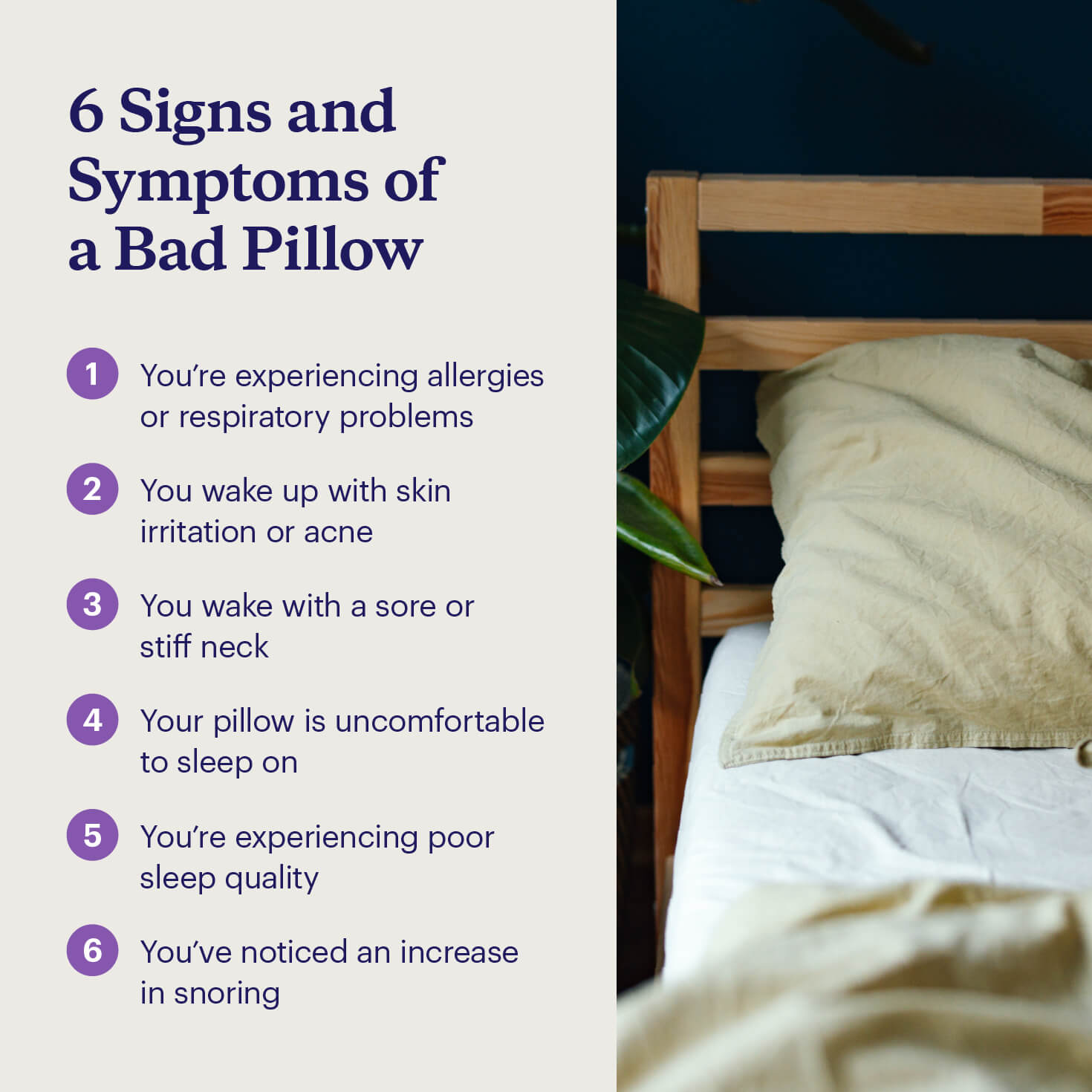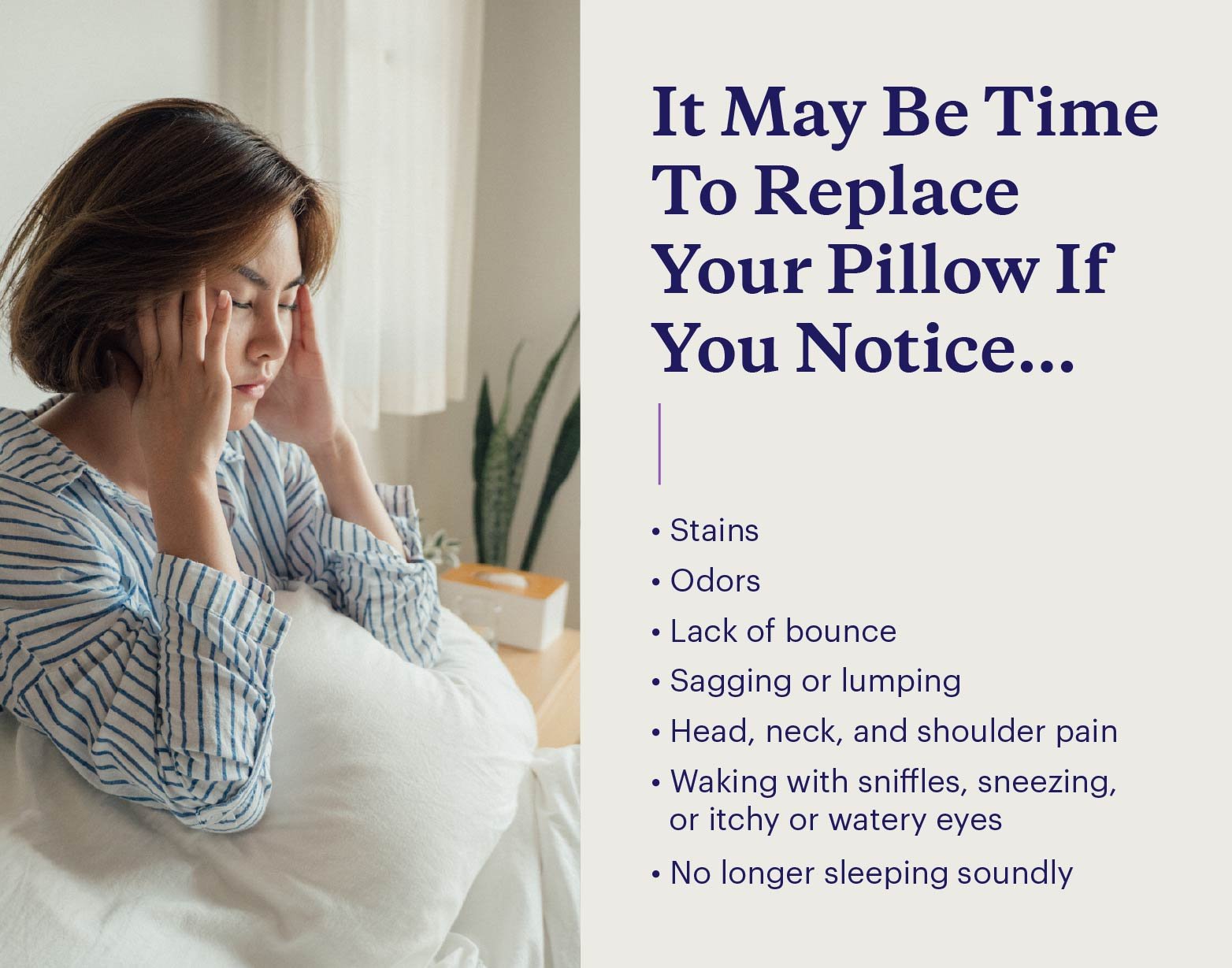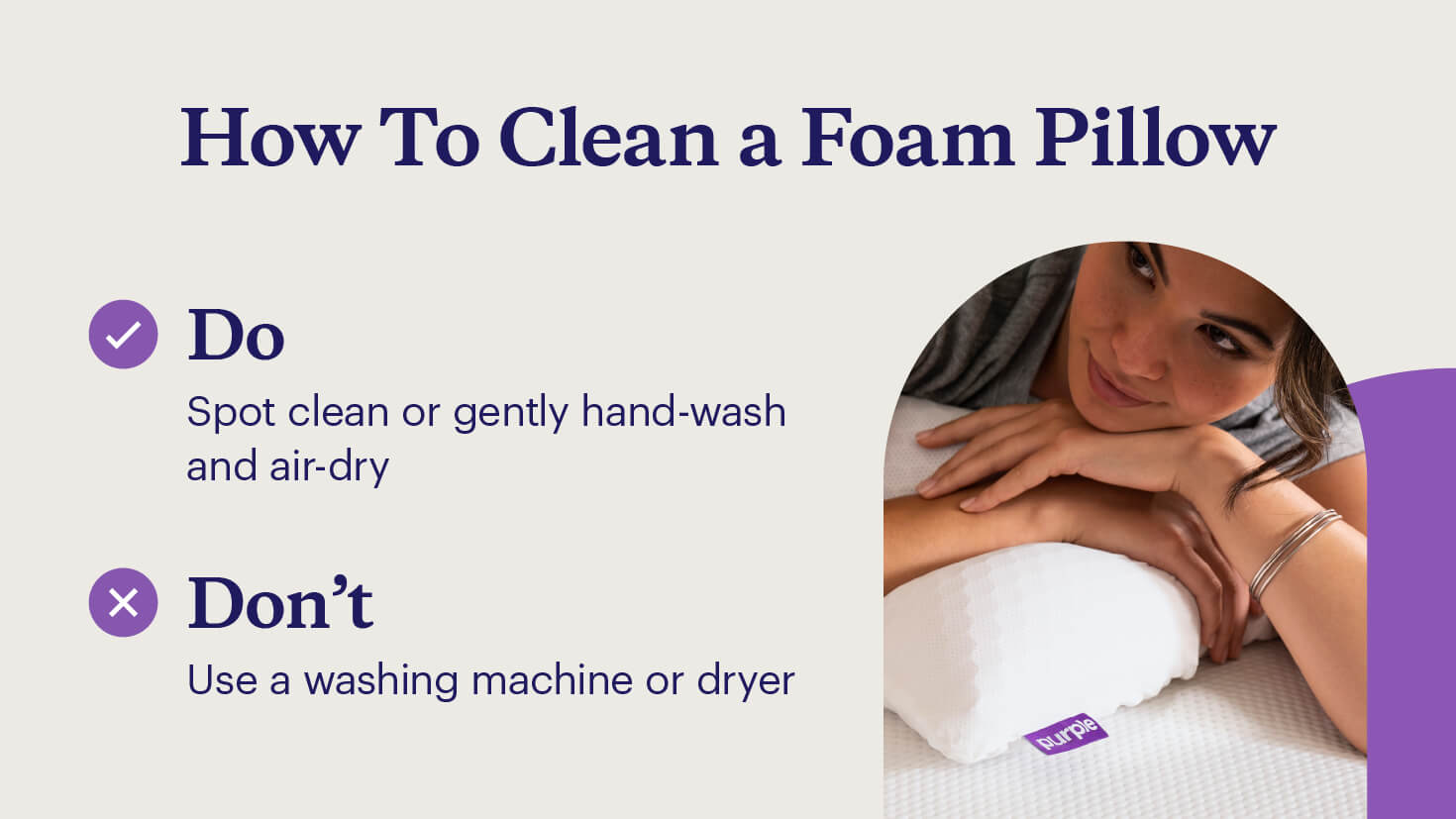How Often Should You Replace Your Pillows? (Bad Pillow Signs & Symptoms)
How often should you get a new pillow? On average, pillows should be replaced every 1 to 2 years to avoid disrupting sleep quality. Pillows wear down from daily use and become less supportive over time. Dust and bacteria also build up, causing a range of bad pillow symptoms that can impact your health.
Sleeping on old pillows can lead to various health issues, such as headaches, chronic neck + back pain, acne, and allergies. This is why you should change your pillows once they show signs of wear.
How often you should replace your pillow depends on your pillow type and its material, but on average, you should expect to purchase a new one every couple of years. Replacing your pillows will help you get better sleep, maintain the hygiene of your bedding, and lead to better health in the long run.
Read on to learn when to replace your pillows, bad pillow symptoms, and what to look for in a new pillow.
How Long Do Pillows Last?
No matter what size pillow you have, you should replace your pillows every 1 to 2 years to ensure they remain allergen-free and maintain a proper level of head and neck support. That said, some pillows are more durable than others and may hold their shape beyond the two-year mark. But even still, allergens and bacteria will become a concern at that point.
Here is the average lifespan of popular types of pillows on the market:
Pillow Type | Lifespan |
| Polyester or down alternative | 6 months to 2 years |
| Down or feather | 18 to 3 years |
| Memory foam or polyfoam | 18 months to 3 years |
| Buckwheat | 3 years |
| Latex | 3 to 4 years |
Reasons Why You Should Replace Your Pillow
According to sleep specialists, pillows can impact almost every part of our sleep quality. That’s why it’s essential to choose the right pillow for you. But it doesn’t just stop at purchasing a high-quality pillow.
Over time, even the cleanest, most premium pillows get beaten out of shape or accumulate yellow stains. As a result, you may experience bad pillow symptoms that become the reason you aren’t sleeping well.
But how exactly can an old pillow impact your health and wellness? Let’s cover a few of the most significant symptoms you could experience from a bad pillow.
1. Allergies and Respiratory Problems
We know you probably don’t want to hear this, but an old pillow provides the perfect environment for germs. Let us explain.
Like old or poorly kept mattresses, pillows invite allergens like dust, mold, and mildew — another reason not to go to bed with wet hair and layers of face creams. That’s not to mention critters like dust mites and bed bugs. In fact, research shows a pillow over two years old can contain 10% of its weight¹ in dead mites and their droppings.
You might be able to keep allergens and mites at bay by tossing the pillow or case into the washing machine, but this is just a temporary solution — and one you’d have to keep up with frequently. Most homes in the U.S. have dust mites, and up to 30% of people² are allergic to them. So once your pillow reaches its life expectancy, it’s best to replace it.
Sleep tip: Be sure to clean your bedding and pillows if you’ve recently fought off a cold or virus.
2. Skin Irritation and Acne
A good night’s rest is critical for all organs, including the body’s largest — skin! Throughout the night, the skin restores itself³ by exfoliating and regenerating new cells. It’s called beauty sleep for a reason.
This exfoliation happens by shedding dead skin cells. Since we actively shed skin cells, sweat, and natural oils onto our pillow cover while we sleep, this dirt and debris can seep into the pillow.
Sleeping on old pillows with this trapped dander can breed allergens + mites and clogs pores — causing acne and other skin issues.
Health fact: The average adult loses almost two grams of dead skin daily — enough to feed one million dust mites.⁴ And over the course of their lifetimes, most people shed around 35 kilograms of skin in total!
3. Lack of Neck Support
Whether you’re using a flexible latex pillow or a breathable bamboo pillow, all types of pillows eventually get worn down and lose their structural integrity. This can cause body and neck pains.
Here are two of the most common signs your pillow is getting bent out of shape:
- Lumps: When your bed pillow accumulates lumps and bumps, it’s time to buy a new one. This is especially true if no amount of fluffing your down and down alternative pillows can restore their downy feel.
- Flatness: A flat pillow results in suboptimal sleep. A deflated cushion means your spinal alignment is disrupted, which can leave you with chronic neck pain even during waking hours.
4. Aches and Pains
Neck pain signs of wear, and yellow spots are all valid reasons to replace your cushion — but this usually isn’t enough to convince most people.
Your pillow can be completely clean and smooth but not comfortable anymore, and that’s a valid reason to seek a new solution. Here are some of the most common causes of an uncomfortable pillow:
- Body and lifestyle changes: This can mean sustaining an injury that requires sleeping in a neutral position or even training yourself to sleep differently. Regardless of what it is, sometimes your old polyester pillows aren’t a good match anymore. Consider purchasing specialty pillows to address your specific concerns.
- A new bed: A new bed means a different balance of support and comfort, which affects everything in your sleep zone. Your old pillow might not sit as you need it to anymore, and that could be a big sign it’s time for a change.
5. Poor Sleep Quality
Do you toss and turn at night? Wake up feeling unrested even after a full night’s sleep? While there are many causes of poor sleep, your pillow could very well be the culprit.
An old pillow that lacks support can disrupt your sleep, causing you discomfort throughout the night. In fact, a bad pillow that’s causing you to toss and turn can even cause motion transfer in bed. If you’re experiencing restless nights and morning fatigue, it might be time to consider a new pillow that better fits your sleep needs.
Sleep tip: For maximum support, the ideal pillow height for most sleepers is between 4 and 7 inches tall.
6. Excessive Snoring
Snoring can be a huge sleep disruptor for you and your partner. And while snoring can be a sign of something else going on, such as sleep apnea, a pillow that doesn’t support your neck properly can also contribute to snoring.
Snoring happens when air passes through a constricted airway. An unsupportive pillow can leave your neck tilted at a low angle, further constricting your airways. If you’ve noticed an increase in snoring, it could be a sign to buy a new pillow.
Look for a pillow that will adequately support your head and neck. The Purple Pillow® features firm support GelFlex® Grid to instantly adapt to your body.
Signs It’s Time To Replace Your Pillow
The 1 to 2-year replacement timeline is a general guideline and not always accurate for each individual or pillow. You may need to consider replacing your pillow early if it’s no longer meeting your needs or causing other issues.
Tell-tale signs that it may be time to replace your pillow include:
- Stains
- Odors
- Lack of bounce
- Sagging or lumping
- Head, neck, and shoulder pain
- Waking with sniffles, sneezing, or itchy or watery eyes
- No longer sleeping soundly
Pillow Care Tips and Replacement Guidelines
Just like mattresses, proper care can help a pillow last longer and stay free of dirt and grime. Pillow maintenance is simple, so it’s worth a couple of extra steps to ensure your pillow is supportive and clean until you’re ready to replace it.
Here are a few quick tips on pillow care:
- Spot-clean stains: If you notice any blood, makeup, or drool stains, spot-clean your pillow immediately and let it air dry before covering it.
- Wash your pillows: Following the manufacturer’s guidelines, wash your pillow every 3 to 6 months.
- Shake it up: When making your bed in the morning, take an extra minute to fluff your pillows, too. Shaking out your pillows regularly can help keep them free from dust and dander.
The table below covers the general cleaning guidelines for each pillow material, but double-check your pillow’s instructions first.
Pillow Type | Care Tips |
| Polyester or down alternative | Machine washable on gentle cycle (may need extra spin cycle); tumble dry low |
| Memory foam or polyfoam | Spot cleaned or gently hand washed; air dry |
| Down or feather | Machine washable on gentle cycle (may need extra spin cycle); tumble dry low |
| Latex | Spot cleaned or gently hand washed; air dry |
| Buckwheat | Machine wash cover only; filling should never get wet |
Purple Pillows
Purple offers several pillows, each made with different high-quality materials that last several years (beyond the one-year warranty). Our hyper-elastic polymer GelFlex® Grid (used in the Purple Harmony™ cooling pillow and Purple Pillow®) bounces back, maintaining its shape for years.
Here are the care guidelines for Purple pillows:
- Purple Harmony™ Pillow: Spot clean core only. Machine wash cover on cold and tumble dry low.
- Purple Pillow®: Hand wash the GelFlex® core with gentle soap and let air dry. Machine wash cover and tumble dry low.
- TwinCloud® and Purple Cloud® Pillows: Machine wash on cold (delicate cycle) and tumble dry low (may require two drying cycles).
- GridCloud Pillow: Machine wash cover on cold (delicate cycle) and lay flat to dry. Spot clean GelFlex Grid layer.
Memory Foam and Polyfoam Pillows
Memory foam and polyfoam pillows typically last between 18 months and three years, depending on the foam quality and structure (whether it’s shredded or solid). You should not clean this type of pillow using a washing machine or dryer. Instead, memory foam pillows should be spot-cleaned or gently hand-washed and air-dried.
Latex Pillows
Latex pillows typically last the longest compared to all other pillow types at three to four years. Like foam, they shouldn’t get submerged in water but instead spot-cleaned or gently hand-washed and laid flat to dry.
Down and Feather Pillows
Made of different types of feathers from ducks and geese, down and feather pillows are similar in durability and care. On average, you should get two years from both pillow types.
Some may be machine washable, but it’s best to double-check the tag before tossing it in the wash. These pillows hold onto moisture quite well, so be sure they’re completely dry before placing them back on your bed.
Polyester and Down Alternative Pillows
Polyester and down alternative (otherwise known as synthetic down) pillows last for a year or two. While both types are typically machine washable on gentle cycles, polyester is a less durable type of pillow stuffing and may begin to fall flat around the six-month mark.
Buckwheat Pillows
Buckwheat pillows are fairly durable and last about three years. These pillows are made from the hull of buckwheat seeds, which are resistant to crushing under the weight of one’s head. However, they can be difficult to care for as you cannot wash the hulls, and they are cumbersome to remove when washing the pillow’s cover.
Upgrade Your Pillow With Purple
If your body feels the mental and physical effects of sleeping on old pillows, a new pillow will feel like a blessing. You’ll sleep better and you might also find that you wake up refreshed and in less pain, partially due to achieving correct spinal alignment by properly sleeping on a pillow.
Consider upgrading to a Purple pillow — whether you’re interested in a down alternative Cloud™ Pillow, or the proprietary GelFlex® Grid in our Purple Harmony™, we have the replacement for you. While each of our pillows offers a unique set of features, they all provide world-class comfort and support.
FAQ
No, pillows do not last 10 years. On average, pillows last for one or two years, though a pillow’s lifespan depends on the materials they’re made of.
You’ll know your pillow is bad and it’s time for a new one when you notice any of these signs:
- Stains
- Odors
- Lack of bounce
- Sagging or lumping
- Head, neck, and shoulder pain
- Allergies
- Snoring due to lack of support
Yes, it’s entirely possible for a bad pillow to cause back and neck pain which can then trigger headaches. When your neck isn’t supported properly, your muscles and nerves can become pinched, causing these aches and pains.
You should wash pillows every three to six months. It’s important to note that not all pillows can be machine washed and may require hand washing or spot cleaning. Review your pillow’s tag or care guide before tossing it in the wash.
You have a few options when it comes to getting rid of old pillows. You can repurpose pillows or their stuffing as outdoor cushions in entertaining spaces, gardening knee mats, or DIY stuffed animals.
Your local animal rescue, homeless shelter, or church may also accept gently used bedding donations for pillows without obvious wear.
Many pillows and mattresses turn yellow due to moisture like sweat, drool, wet hair, lotions, and dead skin cells that seep in as you toss and turn. You can prevent this by:
- Washing your bedding regularly
- Using a pillow protector
- Drying your hair before bed
- Finishing your skincare routine at least 30 minutes before your head hits the pillow
Memory foam and polyfoam pillows also naturally oxidize causing the foam to turn yellow. Oxidation is influenced by factors like UV light, high temperatures, pollution, and moisture. To minimize the foam's discoloration, keep it away from direct sunlight, avoid machine washing, and prevent contact with oils, sweat, and liquids.
Change your bedding at least once a week if not every couple of days — this includes pillowcases and sheets. It’s nice to have extra pillowcases on hand so you don’t have to wait on a laundry cycle to remake your bed or arrange your pillows. The Purple SoftStretch Pillowcase Set offers a silky-smooth feel with moisture-wicking properties.
As for when you should replace bedding, a good rule of thumb is to buy new pillowcases and sheets when you replace your pillow. Most sheets last one or two years, depending on the material.
More to Explore
Level-up your sleep routine with our most-loved products.
Find your perfect pillow
Sleep is about to get a whole lot better — answer a few quick Qs to find the pillow of your dreams.
